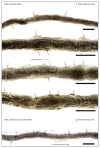Acute idiopathic polyneuritis with spontaneous remission in an Abyssinian cat
- PMID: 26663925
- PMCID: PMC4668811
Acute idiopathic polyneuritis with spontaneous remission in an Abyssinian cat
Abstract
An Abyssinian kitten was presented after a sudden onset of neurological disorders consistent with a polyneuropathy. Electrophysiological and histological investigations revealed an inflammatory polyneuropathy. No infectious agents were detected. Spontaneous recovery occurred rapidly without relapse (2 years follow-up). This is the first description of a histologically confirmed self-limiting feline polyneuritis.
Polyneurite idiopathique aiguë avec rémission spontanée chez un chat Abyssinien. Un chaton Abyssinien a été présenté suite à l’apparition soudaine de troubles neurologiques conformes à une polyneuropathie. Les enquêtes électrophysiologiques et histologiques ont révélé une polyneuropathie inflammatoire. Aucun agent infectieux n’a été détecté. Le rétablissement spontané s’est produit rapidement sans rechute (suivi de 2 ans). Il s’agit de la première description d’une polyneurite féline auto-limitée confirmée par histologie.(Traduit par Isabelle Vallières).
Figures


References
-
- Chrisman CL. Polyneuropathies of cats. J Small Anim Pract. 2000;41:384–389. - PubMed
-
- Dickinson PJ, LeCouteur RA. Feline neuromuscular disorders. Vet Clin North Am Small Anim Pract. 2004;34:1307–1359. - PubMed
-
- Coates JR, O’Brien DP. Inherited peripheral neuropathies in dogs and cats. Vet Clin North Am Small Anim Pract. 2004;34:1361–1401. - PubMed
Publication types
MeSH terms
LinkOut - more resources
Full Text Sources
Miscellaneous
